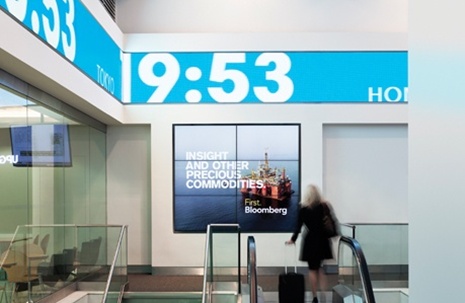Profile interview: Maureen McGuire, CMO, Bloomberg
In a career spanning almost 40 years, Maureen McGuire, chief marketing officer at Bloomberg believes there is no road map to becoming a CMO, but instead shows how common sense has helped her to top roles at IBM, Sears and now at the financial information giant.
Bloomberg is on a mission. Most famous for the financial systems terminal invented by Michael Bloomberg in the 1980s, its aim is to ‘become the indispensable source of information for the world’s most influential people’.
Helping to lead that charge is Maureen McGuire, Bloomberg’s first ever chief marketing officer, tasked with reaching new markets and capitalising on data and digital opportunities.
“We are already strong in the financial markets and people give us credit for being able to report in those markets,” says McGuire.
Earlier this month, the media side of the Bloomberg empire launched the first in a series of multi-platform brands, Bloomberg Politics, and hired Guardian News & Media executive Adam Freeman to run media for the EMEA region.
“We want to be just as important for people in a more general business sense – not just financial – reporting on companies and people that are of interest or issues in the business population and expanding the Bloomberg brand,” says McGuire.
Knowing how she had helped the failing IBM turn itself around in the 1990s during a 30-year career at the company, McGuire’s former boss Abby Kohnstamm asked her to join her on a consulting project at Bloomberg in 2009.
The duo designed a marketing organisation for a company that had never had one and began vetting candidates for the CMO role. After six months, Bloomberg chief executive Dan Doctoroff and chairman Peter Grauer decided that McGuire herself would be the best person for the job.

But it was not an easy start. “The first day I got there I looked around and there was nobody that knew what I was talking about, nobody that spoke my language. I had to start from the very beginning,” she says. “It was a case of rolling up my sleeves and getting to know people, hiring the right team, starting with the right partners internally to pull the marketing programme together and then delivering on it.”
Her 40 years of experience in business helped her to get on with the job, combining this with a down-to-earth approach to marketing apparent on her Twitter profile (where she calls herself a ‘common sense CMO’).
“I think in all of my jobs, and I still think this today, I’m actually the translator for what the company wants to say and what the customer wants to hear. That’s also what I mean by common sense marketers – you always have to put yourself in the shoes of the person receiving the message.”
The same ethos informs the way she communicates with all her colleagues. “I think marketers ‘talk to themselves’ quite a lot, they use language that the rest of the company either doesn’t understand or doesn’t care about,” she says. As a result, she tries to understand what the business is trying to do, talking to staff in the language that they use themselves.
You’ve got to get to the soul of the brand to express it properly. That’s something I can feel in my gut
This entails spending a long time at each company, she says. Marketers who don’t will not learn or make an impact. “You have got to get to the soul of the brand to really express it properly,” she says. “I really know the brand and I feel it in my gut. I know when it’s right and when it’s wrong. I don’t think you learn that in two years: being a marketer for two years in one company and moving to the next [means] you haven’t even seen the impact of the things you have done.”
While she laments the fact that the average CMO tenure is only two years or so, she does concede that spending as much time in one company as she did could be a mistake. “Nobody is spending 30 years at their company any more the way I spent 30 years at IBM. Maybe it’s too long today.”
But she also concedes that there is no fixed way to the top. “Young people ask me: ‘How should I start planning my future, how can I get to the position you got to? Show me the roadmap’,” she says. “But there is no roadmap. I don’t think there is a roadmap for anybody.”

She credits her flair for writing, developed as a language student at Glasgow University, for standing her in good stead for the role.
Putting her teaching plans on hold, she returned to Paris after spending a placement year in the city while at university and applied for a position at the British Embassy.
With none available, she was walked across the street to IBM by one of the embassy staff. It was here that she started as third secretary in the president of IBM Europe’s office. After deciding it would be fun to go into marketing, she then worked in PR and advertising roles, ultimately becoming vice-president of marketing.
“It was very serendipitous that I turned up at IBM, with not a thought of marketing in my head – I probably didn’t know what it was,” she says. “I studied English, French and Spanish and I love languages and being able to write. I think that was probably the heart of what attracted me to marketing.”
And she needed all her skills to help turn around IBM. Devoting so much of her career to that business meant she saw the company’s ups and downs close up, including hair-raising losses in the early 1990s. As McGuire tells it, for many years the tech giant thought it didn’t need marketing. Then in 1993 – the year in which it lost more than $8bn – it hired American Express’s Lou Gerstner as chief executive. The new broom “really believed in the company, and needed marketing and the brand to be strong again,” says McGuire.
Nobody is spending 30 years at their company any more the way I spent 30 years at IBM. Maybe it’s too long today
“Lou brought in a CMO, who I worked for, and we worked hard to build the marketing organisation and rebuild the brand. That’s when I really felt most empowered as a marketer to really do something great and turn the company around.”
During this time McGuire established a leadership position for IBM by creating a category called e-business and ran a successful marketing campaign, showing managers struggling with web-related problems, for several years.
Moving from IBM to retail to get experience with another brand and industry, McGuire began a three-year run at Sears in 2005, at a time when rivals such as Walmart and Target were taking market share from the department store. In this instance, she was tasked with restructuring the marketing function and reviving the brand.

Her time as a marketer has also seen McGuire make substantial progress on an issue that is close to her heart: the promotion of women in business. She has been associated with the not-for-profit organisation Catalyst and served on its board of advisers for 12 years.
In 1975, when McGuire started at IBM, there were hardly any women in senior positions generally – and she remembers learning a lot in those early years about how difficult it is for women to earn a promotion.
At Bloomberg, she co-chairs the women’s committee with Matthew Winkler, its editor-in-chief of news, who, she says, is “a great advocate for making sure that women get their rightful position, not just people employed for him but also correctly representing women in media”.
Her current challenges include the historic opportunities presented by digital media.
“The data that comes from social is huge and to be able to exploit that and leverage it in some way is a challenge that every marketer faces,” she explains. “A second challenge is the constant need to prove that what you are doing provides a return on investment. We all know how difficult it is to prove the value of marketing.”
This is a particular difficulty in a business-to-business environment and in a company that largely relies on its salesforce and the products they sell. These include financial market data terminals, analysis products such as Bloomberg Law and media titles such as Businessweek
“People constantly want to tell you what their product does, and they forget to position it in a way that relates it to a problem that a customer you are selling to has,” says McGuire. “It’s the job of a marketer to constantly turn it the other way around: you can’t just keep telling people about product functions and features, you have to understand what problem they are trying to solve and explain how a product solves their problem.”
It is this attitude that prompted Bloomberg to create an information hub at London City Airport this month. The airport initially approached the company with a view to it taking media space there, but rather than creating advertising, Bloomberg wanted to engage with passengers more deeply (see box, below[1] ) in what it claims is its biggest marketing activity to date.

In a four-decade career, McGuire says the hub is her proudest moment. Not only did she have to convince people internally to run it, but she also worked nightshifts at the airport to transform her ideas into reality and bring the project to fruition with minimal disturbance to passengers.
“When we conceived the idea, we thought: ‘This looks fabulous. Do you think we can actually implement it?’” she says. “We did, and it really looks like the concepts we drew up a year ago, so I’m very proud of that.”
As Dan Doctoroff – Bloomberg’s chief executive and president – explained at the launch: “This was different for two reasons: 3.4 million travellers pass through this airport every year and a very high percentage of them are customers [of ours] or could be.”
The hub sums up the McGuire philosophy: to start and finish with science, with an artistic flourish in the middle. This means a focus on research, creating the experience itself and then, she says, “seeing if you have moved the needle, changed perceptions or driven awareness”.
Large-scale marketing launches such as the hub are not Bloomberg’s focus, she says. They are a cog in the company’s broader plan to target new markets – the latest being Africa – and to reach new businesses and audiences.
As of 1 June, McGuire will take on a consultancy role at Bloomberg, giving it the benefit of her common sense attitude and helping it to become a media titan of the 21st century.
Bloomberg’s empire
Michael Bloomberg founded his company in 1982 and still owns 88 per cent of it. Launching with its Bloomberg Professional service – a private network with data, analytics and financial information used by traders and other finance professionals – it had reached 10,000 customers within 10 years.
It now operates in 192 countries and employs 15,500 people. It comprises products and services in four subject areas.
The Professional Service is accessed through the terminals it became famous for, a computer service that provides real-time financial market data, news and analysis. Trading solutions also form part of this sector.
Enterprise offers standalone solutions for businesses to grow and improve efficiency, minimise operational costs and comply with regulations.
Bloomberg Industries relates to brands within the company offering data, analysis and tools. These include law, government, energy and finance, incorporating legal, tax, regulatory and business information.
Bloomberg also has a large news and media section, disseminating content via terminals, TV, radio, print, online and mobile channels. It publishes books and magazines such as Businessweek and runs a TV network and news agency.
Attributes that will take you to the top
McGuire points to three things that helped her to become a chief marketing officer.
Attitude . “Try to learn as much as possible and work hard, put your hand up for every project, be curious and get involved. People react positively to enthusiasm.”
Learning . “Learn from other people in the business, attach yourself to people that you admire and are good at what they do, and learn from them.”
Be yourself . “Know what is right and wrong and how to treat people. Know when to be firm when you need to be. Stand up for the ideas you believe in and know when to give in when it’s not worth fighting for, which will in turn earn respect.”
There’s the hub
The Hub – which Bloomberg says is its biggest brand initiative to date – launched this month at London City Airport.
Bloomberg was initially approached about advertising at the airport, but when studies indicated that passengers needed deeper insight, it devised a business travel experience in and around the departure lounge.
Its research with 2,000 passengers showed that 61 per cent a year are travelling on business and more than half use a subscription-based financial data service, or work for a firm that does. Of these, 63 per cent are Bloomberg Professional service users.
The survey also found that 60 per cent are flying in from overseas, often from financial centres such as Frankfurt, Geneva and Zurich where Bloomberg has a strong client base. In a three-year deal, it will provide news, data and information in a technology-driven space.
Passengers are now greeted by digital screens tailored to the time of day. As they approach security, a 130-metre ticker displays news headlines, financial data and travel.
A lounge features tablets, copies of Bloomberg’s magazine, television news, a helpdesk and a large media wall.
Bloomberg also sponsors the airport’s free WiFi, with a landing page providing market information.
CV Maureen McGuire
2009 – present
Chief marketing officer, Bloomberg
2005 – 2008
Executive vice president and chief marketing officer, Sears
1975 – 2005
Vice president of marketing, IBM
After a stint as a secretary, moves into marketing, working at its global headquarters, its global services business and becoming vice-president of marketing for its service and technology business.
References
- ^ see box, below (www.marketingweek.co.uk)









